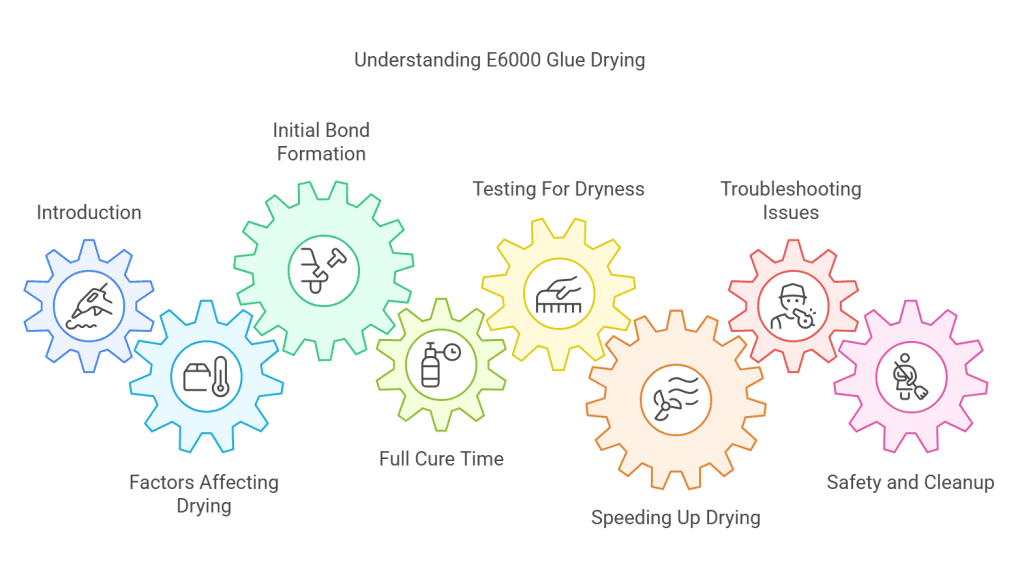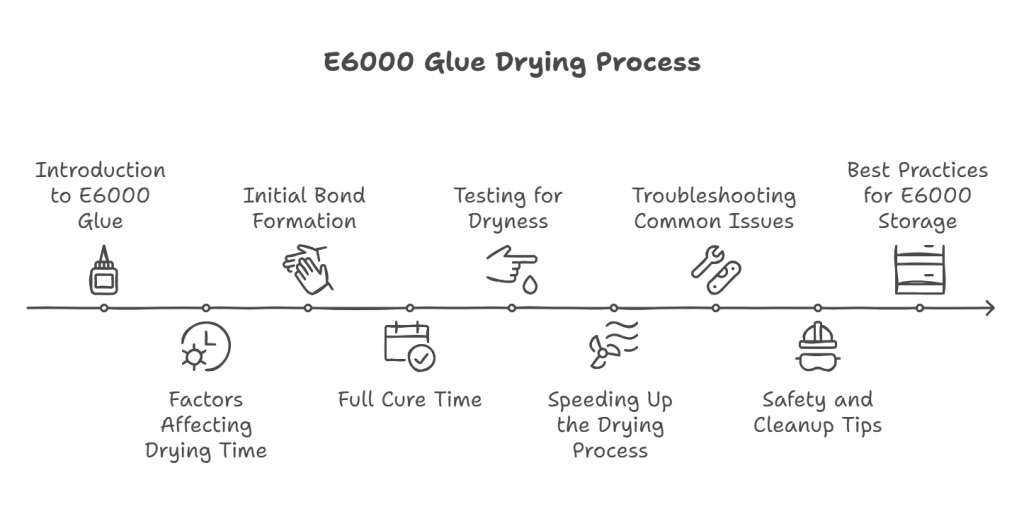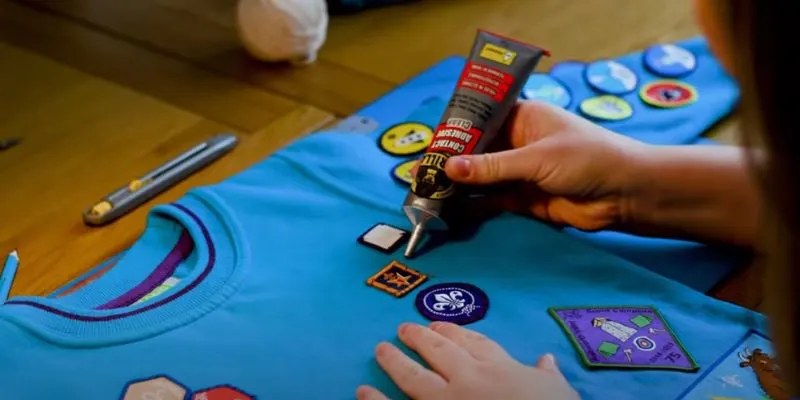E6000 glue typically takes 24 to 72 hours to fully cure. Initial set time is around 10 to 30 minutes, depending on conditions.
E6000 glue is a versatile adhesive known for its strong bond and flexibility. Many users appreciate its effectiveness in various projects, from crafts to repairs. Understanding its drying time can help you plan your tasks better. The glue cures through a process called solvent evaporation, which varies based on temperature and humidity.
For optimal results, ensure surfaces are clean and fit tightly together. Knowing how long E6000 takes to dry will enhance your project efficiency and prevent any mishaps. Whether you’re working on fabric, wood, or metal, this information is crucial for successful application and durability.
Introduction To E6000 Glue
E6000 glue is a strong and versatile adhesive. It works well on many surfaces. This glue can bond wood, metal, glass, and more. It is perfect for crafts, repairs, and DIY projects.
Some common uses include:
- Jewelry making – E6000 is great for attaching beads and stones.
- Home repairs – Use it for fixing broken items around the house.
- Craft projects – Perfect for gluing various materials together.
- Fabric bonding – Ideal for attaching fabric to different surfaces.

Factors Affecting Drying Time
The drying time of E6000 glue depends on various factors. Temperature plays a crucial role. Higher temperatures can speed up the drying process. Low temperatures will slow it down significantly.
Humidity also affects drying. High humidity levels can make the glue take longer to dry. Material types influence how quickly the glue sets. Porous materials absorb glue, causing faster drying.
Surface area matters too. A larger surface area can lead to longer drying times. Thin layers of glue dry faster than thick layers. Consider these factors for best results.
Initial Bond Formation
E6000 glue is popular for its strong hold. The initial bond formation happens quickly. Users often notice tackiness within 10 to 20 minutes. This allows for some adjustments to the project.
After this period, it is easier to reposition items. However, the glue is not fully cured yet. The full drying time can take up to 24 to 72 hours. This time depends on factors like temperature and humidity. Ensure the area is well-ventilated for best results.

Full Cure Time
The full cure time for E6000 glue can vary. Typically, it takes 24 to 72 hours to fully cure. This time depends on several factors. Temperature and humidity can influence drying time.
For the best results, allow the glue to cure in a warm, dry place. This helps maximize strength. Avoid moving the bonded items during the curing process. Doing so can weaken the bond.
Here’s a quick overview:
| Condition | Drying Time |
|---|---|
| Room Temperature | 24-48 hours |
| High Humidity | Up to 72 hours |
| Low Temperature | Longer than 72 hours |
Testing For Dryness
Testing for dryness is important with E6000 glue. Use simple techniques to check. First, gently touch the glue with your finger. If it feels tacky, it’s not dry yet.
Another method involves bending the bonded materials. If they move easily, the glue is still wet. Avoid placing stress on the bond too soon.
Wait for the glue to cure fully before using the item. Rushing can lead to weak bonds. Always follow the recommended drying time on the label.
Check your work area for any signs of moisture. Humidity can slow down the drying process. Keep the area warm and dry for the best results.

Speeding Up The Drying Process
To speed up the drying of E6000 glue, try using heat. A heat gun or hair dryer works well. Keep the tool at a safe distance. This helps avoid damage to the project.
Good ventilation is also key. Open windows or use a fan to increase air flow. This can help the glue dry faster.
Avoid applying too much glue. A thin layer dries quicker than a thick one. Let the glue sit for a while before moving the item.
Stay away from moisture. High humidity can slow down the drying process. Ensure the workspace is dry for better results.
Troubleshooting Common Issues
Slow drying of E6000 glue can happen for several reasons. Humidity and temperature play a big role. High humidity can cause the glue to take longer to set. Ensure you are working in a well-ventilated area to help speed up drying. If the glue is old, it may not dry well. Check the expiration date on the bottle.
Another common issue is applying too much glue. Use a thin layer for better adhesion. If the surfaces are not clean, the glue might not stick. Make sure to clean surfaces before applying. If adhesion failures occur, try these solutions:
| Issue | Solution |
|---|---|
| Slow drying | Increase air circulation |
| Poor adhesion | Clean surfaces thoroughly |
| Old glue | Replace with fresh glue |
Safety And Cleanup Tips
Ensure proper ventilation when using E6000 glue. Open windows and use fans. This helps reduce harmful fumes. Always wear personal protective equipment (PPE) like gloves and masks. This protects your skin and lungs.
For spills, act quickly. Use a cloth to wipe away excess glue. If the glue dries, use acetone to remove it. Test the acetone on a small area first. Always follow safety guidelines during cleanup.
Keep your workspace clean and organized. Store glue and supplies in a safe place. Make sure children and pets stay away from these materials.
Best Practices For E6000 Storage
Storing E6000 glue properly can greatly extend its shelf life. Keep the glue in a cool, dry place. Avoid direct sunlight and high temperatures. A temperature range of 60°F to 80°F works best.
Always close the cap tightly after use. This prevents air from entering the tube. Air exposure can lead to premature drying. Use a container to store the glue upright. This keeps the tip clear of any residue.
Check the expiration date on the packaging. Using glue past its expiration can reduce its effectiveness. Regularly inspect your glue for changes in texture or smell. Discard any glue that appears clumpy or has a bad odor.
Frequently Asked Questions
How Long Does E6000 Glue Take To Set?
E6000 glue typically takes about 10 to 20 minutes to set. However, it may take up to 24 hours for a full cure. Factors like humidity and temperature can affect drying times. Always allow ample time for optimal bonding strength.
Can E6000 Glue Be Used On Fabric?
Yes, E6000 glue is suitable for fabric projects. It creates a strong, flexible bond that withstands washing. However, always test it on a small fabric piece first. This ensures compatibility and prevents unwanted results.
Is E6000 Waterproof Once Dry?
Yes, E6000 glue is waterproof once fully cured. It can withstand exposure to water and moisture without breaking down. This feature makes it ideal for both indoor and outdoor projects. Ensure it is completely dry before exposing it to water.
How To Speed Up E6000 Glue Drying?
To speed up E6000 glue drying, use a fan or heat source. Increased airflow and gentle heat can help reduce drying time. However, avoid direct heat, as it may damage the materials. Always follow the manufacturer’s guidelines for best results.
Conclusion
Understanding E6000 glue’s drying time is essential for successful projects. Typically, it takes 24 to 72 hours to fully cure. Patience is key to achieving a strong bond. Always follow the manufacturer’s instructions for the best results. With proper care, your projects will withstand the test of time.
Happy crafting!

